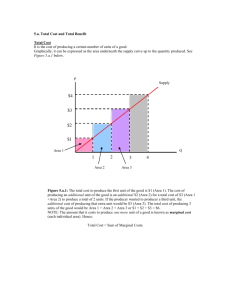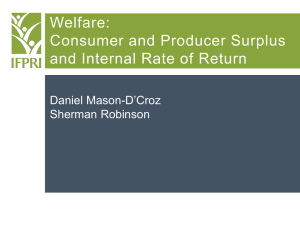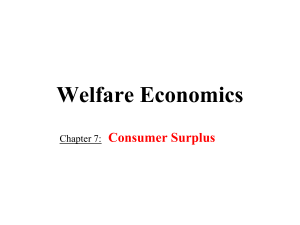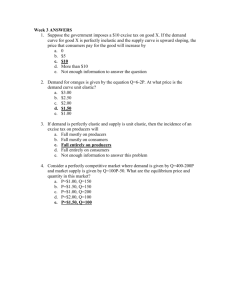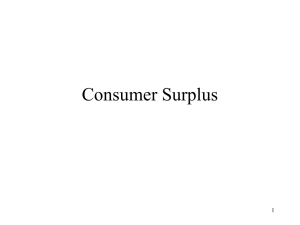Homework 6 - Economics
advertisement
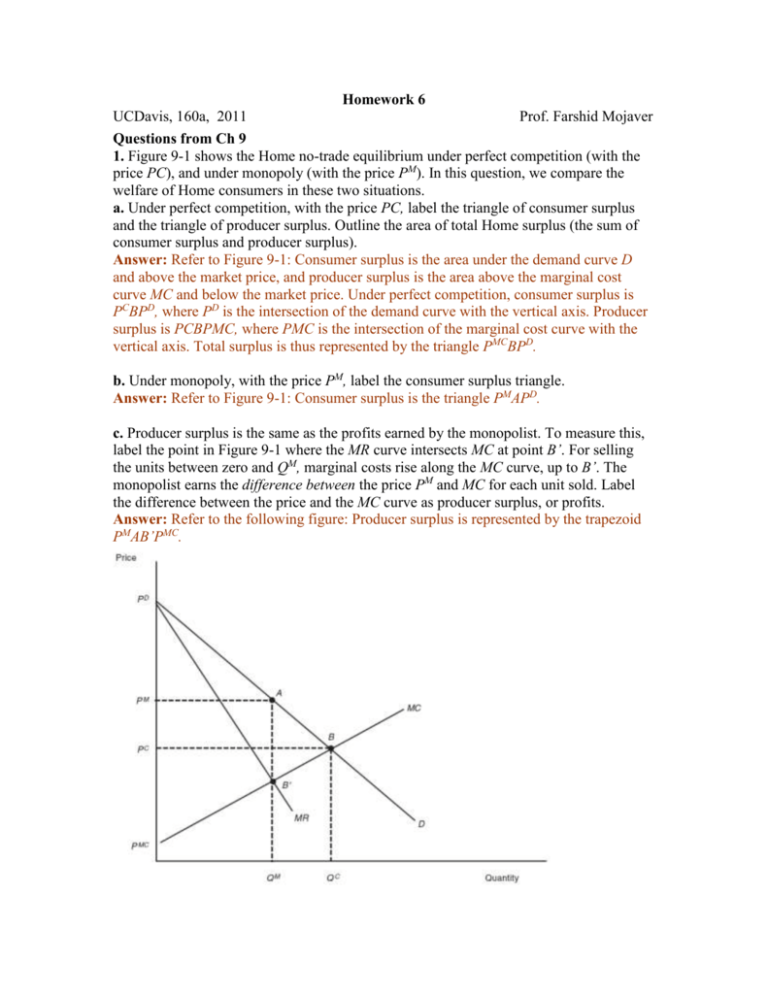
Homework 6 UCDavis, 160a, 2011 Prof. Farshid Mojaver Questions from Ch 9 1. Figure 9-1 shows the Home no-trade equilibrium under perfect competition (with the price PC), and under monopoly (with the price PM). In this question, we compare the welfare of Home consumers in these two situations. a. Under perfect competition, with the price PC, label the triangle of consumer surplus and the triangle of producer surplus. Outline the area of total Home surplus (the sum of consumer surplus and producer surplus). Answer: Refer to Figure 9-1: Consumer surplus is the area under the demand curve D and above the market price, and producer surplus is the area above the marginal cost curve MC and below the market price. Under perfect competition, consumer surplus is PCBPD, where PD is the intersection of the demand curve with the vertical axis. Producer surplus is PCBPMC, where PMC is the intersection of the marginal cost curve with the vertical axis. Total surplus is thus represented by the triangle PMCBPD. b. Under monopoly, with the price PM, label the consumer surplus triangle. Answer: Refer to Figure 9-1: Consumer surplus is the triangle PMAPD. c. Producer surplus is the same as the profits earned by the monopolist. To measure this, label the point in Figure 9-1 where the MR curve intersects MC at point B’. For selling the units between zero and QM, marginal costs rise along the MC curve, up to B’. The monopolist earns the difference between the price PM and MC for each unit sold. Label the difference between the price and the MC curve as producer surplus, or profits. Answer: Refer to the following figure: Producer surplus is represented by the trapezoid PMAB’PMC. d. Outline the area of total Home surplus with a Home monopoly. Answer: Refer to the figure from part (c): Total surplus is represented by the trapezoid PDAB’PMC. e. Compare your answer with parts (a) and (d) and outline the difference between these two areas. That difference is called the deadweight loss due to monopoly. Answer: Refer to the figure from part (c): The deadweight loss due to monopoly is represented by the triangle ABB’. 2. Figure 9-2 shows the free-trade equilibrium under perfect competition and under monopoly (both with the price PW). In this problem, we compare the welfare of Home consumers in the no-trade situation and under free trade. a. Under perfect competition, with the price PW, label the triangle of consumer surplus and the triangle of producer surplus. Outline the area of total Home surplus (the sum of consumer surplus and producer surplus). Answer: Refer to the following figure: The free-trade equilibrium under perfect competition has a Home consumer surplus of PDB’PW, and a producer surplus of PWBPMC. b. Based on your answer to part (a) in this problem and part (a) of the last problem, outline the area of gains from free trade under perfect competition. Answer: Refer to the figure from part (a): Gains from trade are represented by the shaded triangle. c. Under monopoly, still with the price PW, again label the triangle of consumer surplus and the triangle of producer surplus. Answer: Refer to the figure from part (a): The free-trade equilibrium under monopoly has a Home consumer surplus of PDB’PW, and a producer surplus of PWBPMC . This is identical to the free-trade surplus under perfect competition. d. Based on your answer to part (c) in this problem and part (d) the last problem, outline the area of gains from free trade under Home monopoly. Answer: Refer to the following figure: Gains from trade are represented by the shaded area. e. Compare your answer with parts (b) and (d). That is, which area of gains from trade is higher and why? Answer: The area representing gains from trade is larger in part (d) than in part (b). This is because the opening of trade in the monopoly case eliminates the monopolist’s ability to charge a price higher than the perfectly competitive price. As such, trade additionally eliminates the deadweight loss associated with monopoly, making gains from trade higher. 3. Why is it necessary to use a market failure to justify the use of infant industry protection? Answer: If all markets are working perfectly, there is no reason why a potentially successful fledgling industry cannot survive without government intervention. Let us consider the two justifications for using an infant industry tariff. The first is that the industry will learn over time, which will drive down its average costs to the point where it is competitive; if credit markets were working perfectly, that industry could borrow against future profitability to keep it in business until that time. The second justification explicitly assumes a market imperfection: A positive externality in production implies that the socially optimal level of infant industry output is above that determined by the market equilibrium. 4. What is a positive externality? Explain the argument of knowledge spillovers as a potential reason for infant industry protection. Answer: Positive externality exists when the increase in production by one firm generates benefits to other firms by lowering industry costs. By imposing the tariff, the government could nurture the infant industry because the increase in output allows the firms to reduce their future costs by learning from each other. Without the protection, each firm on its own would lack the incentive to invest in learning through increasing its current production. 5. If infant industry protection is justified, is it better for the Home country to use a tariff or a quota, and why? Answer: To the extent that the Home infant industry has market power, it is better to use a tariff rather than a quota. The infant industry calculus weighs the benefits of future producer surplus against current deadweight losses due to protection. Because deadweight losses are greater under a quota due to maintaining Home market power, infant industry protection has a better chance of being worthwhile by using a tariff. 6. In this problem, we analyze the effects of an import quota applied by a country facing a Foreign monopolist. In Figure 9-10, suppose that the Home country applies an import quota of X2, meaning that the Foreign firm cannot sell any more than that amount. a. To achieve exports sales of X2, what is the highest price that the Foreign firm can charge? Answer: Refer to the following figure: To achieve export sales of exactly X2, the Foreign monopolist would charge P2. b. At the price you have identified in part (a), what is the Home consumer surplus? Answer: Refer to the figure in part (a): Home consumer surplus is represented by the shaded triangle with area b. c. Compare the consumer surplus you identified in part (b) with the consumer surplus under free trade. Therefore, outline in Figure 9-10 the Home losses due to the quota. Hint: Remember that there is no Home firm, so you do not need to take into account Home producer surplus or tariff revenue. Assume that quota rents go to Foreign firms. Answer: Refer to the figure in part (a): Consumer surplus under free trade is a triangle with area b + c + d. Under a quota, consumer surplus decreases by c + d. The Home welfare loss due to the quota is thus area c + d. d. Based on your answer to (c), which has the greater loss to the Home country: a tariff or a quota, leading to the same level of sales X2 by the Foreign firm? Answer: Because there is no terms-of-trade gain associated with the quota, welfare is lower under a quota regime relative to a tariff regime. 7. Consider the case of a Foreign monopoly with no Home production, shown in Figure 9-10. Starting from free trade at point A, consider a $10 tariff applied by the Home government. a. Assuming that the demand curve is linear, as in problem 10 of Chapter 6, what is the shape of the marginal revenue curve? Answer: The shape of the marginal revenue curve is also linear, but twice as steep. b. Therefore, how much does the tariff-inclusive Home price increase because of the tariff, and how much does the net-of-tariff price received by the Foreign firm fall? Answer: Because the marginal revenue curve is steeper than the demand curve (twice as steep in this case), the vertical increase along the marginal revenue curve of $10, reflecting the tariff, is twice as much as the corresponding vertical increase along the demand curve. Thus, the Home tariff-inclusive price increases by $5 and the net-of-tariff Foreign price decreases by $5. c. Discuss the welfare effects of implementing the tariff. Use a graph to illustrate under what conditions, if any, there are increases in Home welfare. Answer: Refer to the following figure: The tariff decreases Home consumer surplus by the area c _ d, increases government revenue by the area c, and improves Home’s terms of trade by the area e. Thus if e exceeds d, there is an overall welfare gain from the tariff. Problem Set 3: Trade Policy 2:Export Subsidies and other policy tools Problem 1. Which of the following are potentially valid arguments for tariffs or export subsidies, and which are not (explain your answers)? a. “The more oil the United States imports, the higher the price of oil will go in the next world shortage.” This could make a valid argument for import tax. This works like tax on foreign monopoly. b. “The growing exports of off-season fruit from Chile, which now accounts for 80 percent of the U.S. supply of such produce as winter grapes, are contributing to sharply falling prices of these former luxury goods.” This does not make a good case for import tariff. Winter grapes are no competing Home Summer grapes and thy don’t have any negative externalities. c. “U.S. farm exports don’t just mean higher incomes for farmers – they mean higher income for everyone who sells goods and services to the U.S. farm sector.” This argument can be made more or less about any industry. This doe not make a good argument for protection. d. “Semiconductors are the crude oil to technology; if we don’t produce our own chips, the flow of information that is crucial to every industry that uses microelectronics will be impaired.” This could make a good case for infant industry and thus some sort of protection including import tariff. e. “The real price of timber has fallen 40 percent, and thousands of timber workers have been forced to look for other jobs.” This is not a good argument for protection. There is no particular externality associated with the timber industry. And protection is not a good policy for keeping jobs. Problem 2 On the following page of this problem set there is a three panel graph. In the left hand panel are the demand and supply curves in the Home country for some good Q. In the right hand panel are the demand and supply curves for the Foreign country for the same good. Both Home and Foreign are "large" countries. A. (a) In the middle panel, draw the import demand (MD) and export supply (XS*) curves for Home and Foreign, respectively. Be sure to label the curves. (b) Label the equilibrium world price in free trade as Po W, and indicate quantities consumed (QD) and produced (QS) in each country, as well as the quantity of good Q traded (label this Mo). B. Suppose that Foreign imposes a specific export tax of $t. (a) Show the new equilibrium price in Home and in Foreign, plus the new level of good Q traded (label this M1). Also indicate the new quantities produced and consumed in each country. (b) Label the areas in the right hand panel. Relative to free trade, what is the i) change in Foreign consumer surplus? CS* = b + c ii) change in Foreign producer surplus? PS* = -[ b + c + d + e + f ] iii) change in the Foreign government’s revenue? Gov R* = a + e iv) total change in Foreign’s welfare. Explain why/whether Foreign’s export tax makes Foreign better off. .W* = a – d - f The total effect of an export tax imposed by foreign is ambiguous. It depends on the size of the government revenue and the dead weight losses that results from over consumption and under production in the foreign country. (c) Label the areas in the left hand panel. Relative to free trade, what is the i) change in Home consumer surplus? CS = -[ a + b + c + d ] ii) change in Home producer surplus? PS = a iii) change in Home government’s revenue? Gov R = 0 iv) total change in Home welfare? Explain why/whether Foreign’s export tax makes Home worse off. W = -[ b + c + d ] (d) Define global welfare as the sum of consumer surpluses, producer surpluses, and government revenues for each country. Using the labeled areas from the graph, what is the effect of the export tax on global welfare? Does the export tax raise/lower/have an ambiguous effect on global welfare? Wg = a - [ b + c + d + d + f ] = - [ b + d + d + f ] for a = c. Does the export tax raise/lower/have an ambiguous effect on global welfare? The export tax has a negative effect on global welfare for a = c. C. Indicate on the graph above the VER that would be equivalent to Foreign’s export tax t. (a) Would Home be better off/worse off/indifferent if Foreign used a VER instead of an export tax? Explain. Home is indifferent to foreign using a VER or an export tax to restrict trade. Home faces the same import price as before. The difference is now that the foreign producers now receive the government revenue, previously collected by the foreign government from the tax, as rents derived from their restricted production. (b) Would Foreign producers be better off/worse off/indifferent if Foreign used a VER instead of an export tax.? Explain. Foreign producers will definitely better off with a VER than an export tax. With the tax they have to pay areas a & e to the government while with the VER they would receive this money in the form of rents (This is assuming that the foreign producers get the VER rents. The government may allocate them in a different way). Chapter 11: Trade Creation and Diversion, Strategic trade 1. As a result of political and economic liberalization in Eastern Europe, it seems increasingly likely that Eastern European nations such as Poland and Hungary may join the European Union in the near future. Discuss the potential economic costs of such an expansion of the European Union, from the point of view of (1) Western Europe; (2) Eastern Europe; and (3) other nations (like the U.S.). The potential economic costs associated with the entrance of Poland and Hungary into an expanded EU depend largely on whether their membership results in trade creation or trade diversion. (1) The Western nations should also be concerned on the trade creation versus trade diversion aspects of the entry of Poland and Hungary. For distributional and political reasons, they may be concerned about whether the prices of their own products will be driven down by competition or whether the entrants will simply bring to the Western markets an expanded variety of products and scope for additional scale economies of production. Workers in Western markets may be concerned that inflows of foreign labor drive down wages, although, as we have observed in previous chapters, the nominal wage shifts should be considered in light of changes in the prices of consumption goods. (2) In particular, Poland and Hungary will gain if they engage in new trade with Western Europe although they might lose if trade within the European Union simply replaces trad,e which had been occurring with Eastern bloc countries. Furthermore, both of these nations will face at least higher structural unemployment during the transition period. Some of the negative effects on workers might be lessened if labor mobility is permitted across borders. (3) Countries outside of the EU, such as the United States and Japan, would express concern if the supplies of products to the EU by Poland and Hungary substitute for goods previously supplied by the United States and Japan. The large outsiders, however, could reap substantial positive gains from having expanded access to the consumers of Poland and Hungary. 2.The U.S. Commerce Department has urged that the United States provide special support for high-technology industries. It argues that these industries have the prospects of rapid future growth, provide inputs to many other industries, and generate technology that benefits the whole economy. Furthermore, some U.S. high-technology industries such as aircraft and microelectronics face challenges by government-supported foreign competitors. Which of these arguments might be valid reasons for the United States to have a policy targeting these industries? A valid reason for supporting high-technology industries would be that they generate technologies which benefit the whole economy. The value to the whole economy of this aspect of the high-technology firms' existence exceeds the benefits to the firms themselves, and there will be too little expansion of these firms from a social point of view. Other stated benefits are not valid reasons for industrial policy since the market provides incentives for the realization of these benefits. The protection from foreign competition is also a spurious argument since, as has been shown in previous chapters, the economy as a whole benefits from cheap foreign high-technology goods. The exception being if the industry provides monopoly rents and the foreign government is trying to capture these rents for its home economy. 3. Does the U.S. military budget help or hurt the strategic position of U.S. hightechnology industries? Make the case for either point of view. The potential gains for the high technology industries depend on the extent to which a great deal of government sponsored research and development is filtered through the military budget. This is especially relevant when military expenditures on research and development have spillover effects and produce a marginal social gain of knowledge which benefits other firms in U.S. industry. However, there are several caveats to this argument. To the extent that military industry is particularly concentrated and oligopolistic, there may be a serious market failure. More importantly, there remains the issue of how relevant and applicable will be any knowledge spillovers from military research and development to the high technology sectors. Moreover, the military fields may be siphoning off many highly talented researchers from civilian high-technology industries. Much of it may not be well-suited. In this case, the goal of developing a broad application to high technology through military research would not be a well-targeted program. 4. Suppose that the European Commission asked you to develop a brief on behalf of subsidizing European software development –bearing in mind that the software industry is currently dominated by U.S. firms, notably Microsoft. What arguments would you use? What are the weaknesses in those arguments? A primary argument must be that there is some sort of market failure that voids the standard logic of free trade. One might argue that Microsoft’s’ monopoly position allows it to capture excessive profits, and that its market power dissuades entry. A statesponsored firm might be able to over-come these entry costs. Furthermore, the software industry may have numerous knowledge spillovers with other industries and high-tech applications that make it desirable to have some local presence even if the local industry loses money. On the other hand, Microsoft may be a natural monopoly. It is much easier for the world to have one computer standard. Furthermore, state direction of an industry where innovation is so important is unlikely to be successful. Finally, in software, physical location may be of minor importance as ancillary industries could develop anywhere and use modern telecommunications technology to interact with U.S. based software firms.




